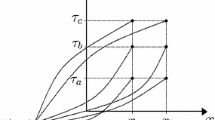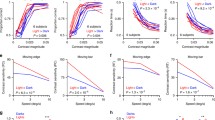Abstract
The purpose of this study is to construct a functional model of the human visual system in its response to certain classes of moving stimuli.
Experimental data are presented describing the interdependence of the input variables, temporal frequency, spatial period, etc., for two constant response states, viz. threshold motion response and threshold flicker response. On the basis of these data, two basic units are isolated, a vertical (V) unit and a horizontal (H) unit. The H-unit is identified with the Reichardt multiplier (Reichardt and Varju, 1959), and the V-unit with the de Lange filter (de Lange, 1954).
A definition of the general motion response of the H-units is obtained, and this is then reduced to an expression which may be applied directly to the observed motion response data. By this method, Thorson's simplification of the Reichardt scheme (Thorson, 1966) is adopted for the H-unit and total and relative (population) weighting factors, associated with the H-unit output, are defined.
In order to reconcile the theoretical square-wave threshold motion response with the experimental data, Thorson's simplification is modified with the introduction of a low-pass filter on the output. The amended scheme is shown to predict a (temporal) frequency-dependent phase-sensitivity. This prediction is tested experimentally, and its validity indicated.
Similar content being viewed by others
References
Ditchburn, R. W., Ginsborg, B. L.: Involuntary eye-movements during fixation. J. Physiol. (Lond.) 119, 1–17 (1953).
Dzn, H. de Lange: Relation between critical flicker frequency and a of low frequency characteristics of the eye. J. opt. Soc. Amer. 44, 380–389 (1954).
Foster, D. H.: The perception of moving spatially-periodic intensity distributions. Optica Acta 15, 625–626 (1968).
—: The response of the human visual system to moving spatially-periodoc patterns. Vision Res. 9, 577–590 (1969).
Foster, D. H.: Some experiments on the detection of motion by the human visual system and their theoretical interpretation. Ph. D. Thesis, University of London 1970a.
Foster, D. H.: The response of the human visual system to moving spatially-periodic patterns: Further analysis. Vision Res. in press (1970b).
Gilbert, D. S., Fender, D. H.: Contrast thresholds measured with stabilized and non-stabilized sine-wave gratings. Optica Acta 16, 191–204 (1969).
Licklider, J. C. R.: A duplex theory of pitch perception. Experientia (Basel) 7, 128–134 (1951).
Reichardt, W., Varju, D.: Übertragungseigenschaften im Auswertesystem für das Bewegungssehen. Z. Naturforsch. 146, 674–689 (1959).
Spekreijse, H., Oosting, H.: Linearizing: A method for analysing and synthesizing nonlinear systems. Kybernetik 7, 22–31 (1970).
Thorson, J.: Small signal analysis of a visual reflex in the Locust: II. Frequency dependence. Kybernetik 3, 53–66 (1966).
Veringa, F.: On some properties of non-threshold flicker. J. opt. Soc. Amer. 43, 500–502 (1958).
Author information
Authors and Affiliations
Rights and permissions
About this article
Cite this article
Foster, D.H. A model of the human visual system in its response to certain classes of moving stimuli. Kybernetik 8, 69–84 (1971). https://doi.org/10.1007/BF00288735
Received:
Issue Date:
DOI: https://doi.org/10.1007/BF00288735




